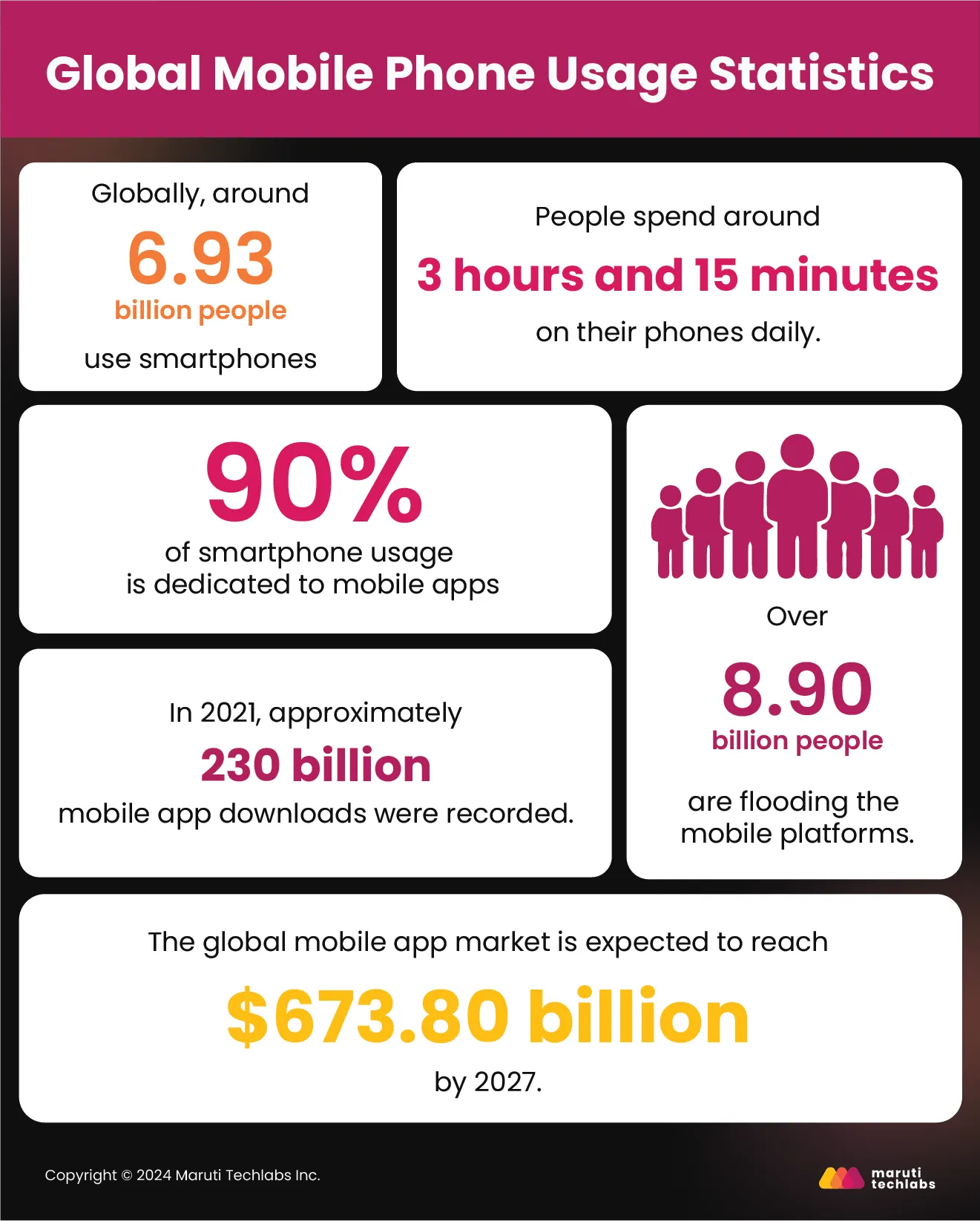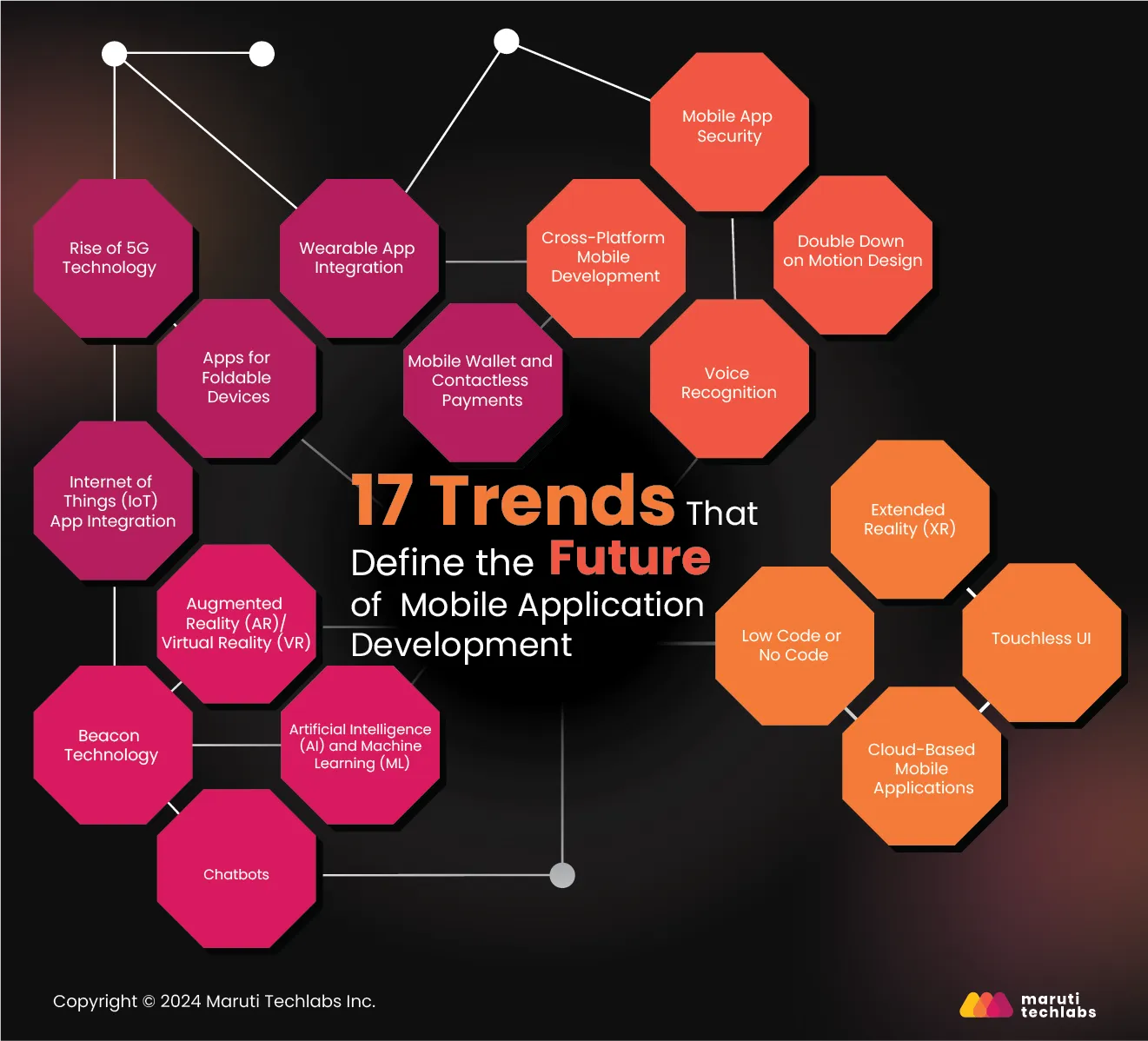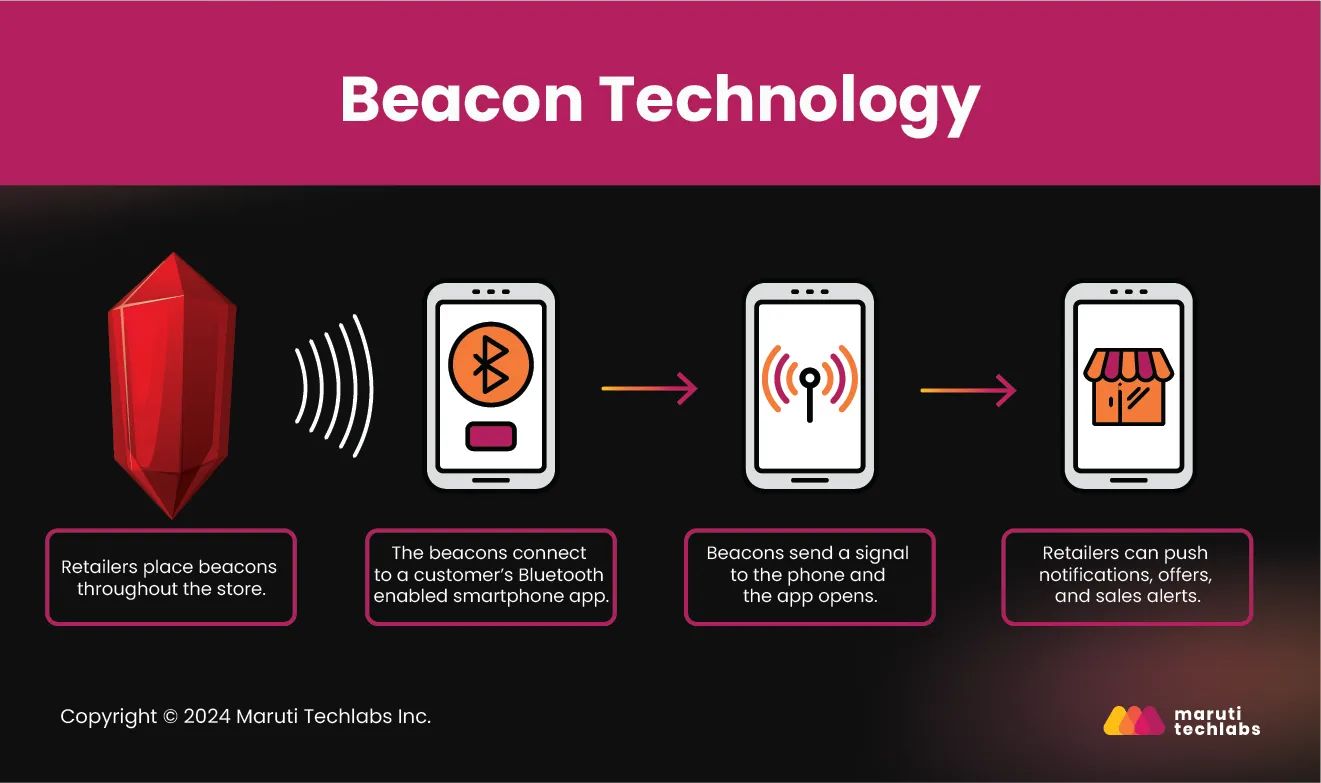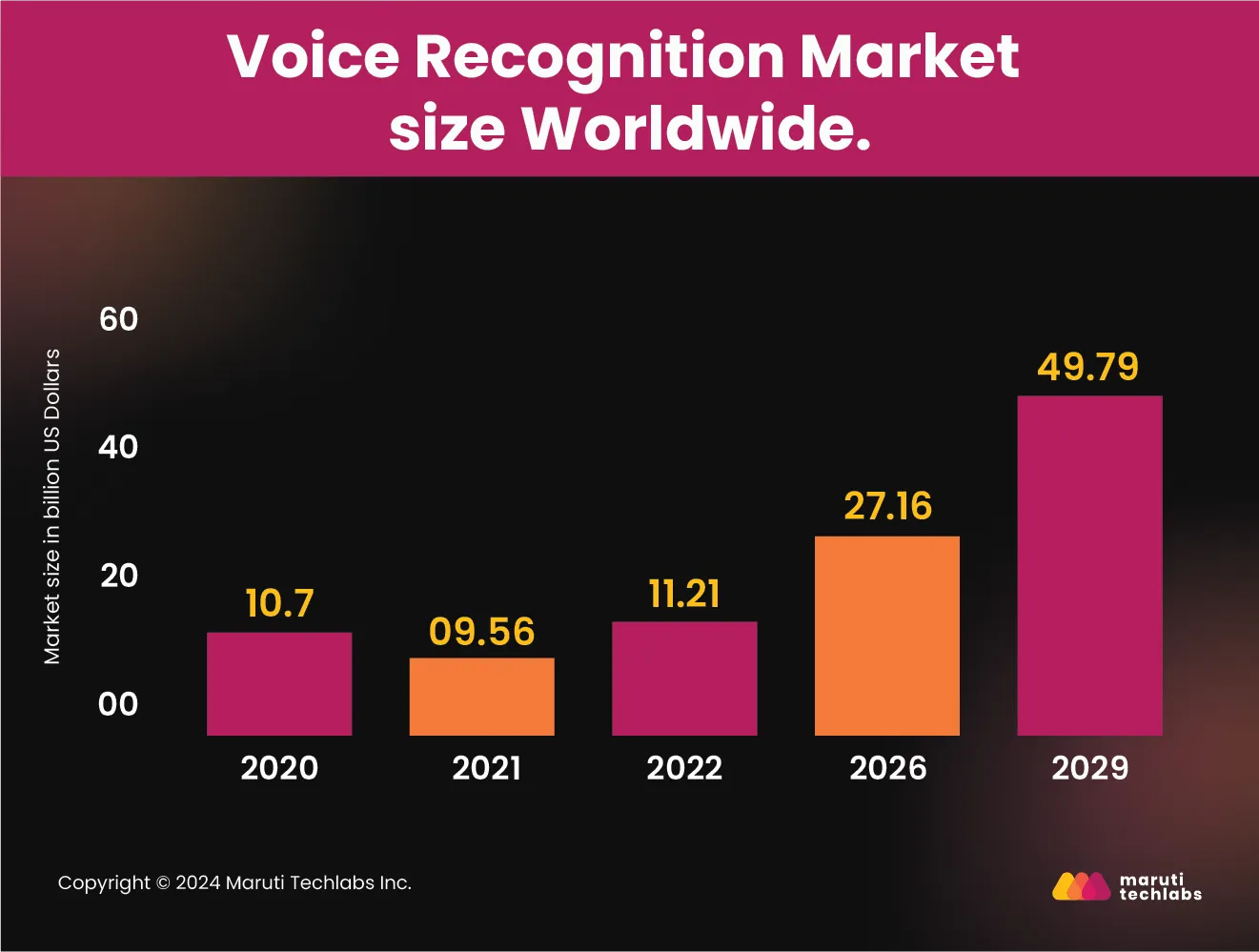

Top 17 Mobile App Development Trends to Know in 2025






Amazon, Netflix, Facebook, and YouTube—these small start-ups, big breakout businesses—have achieved unprecedented success in the digital era. But have you ever wondered how? - By astutely realizing the potential of mobile app technology way before its boom.
As mobile phones rapidly became widespread, these tech giants swiftly transitioned into the mobile era, bringing everything from finance to fitness, entertainment to shopping —zipped into our pockets.
Since then, the mobile app landscape has exploded radically. Today, we have an app for everything! Grocery shopping, gaming, flight booking, news reading, studying, dating, photo editing, you name it, and there’s an app sitting in the app store!

Here’s a glimpse of the latest statistics highlighting the rampant use of mobile apps:
Such intense competition and evolving user expectations demand continuous innovation. Just being on mobile is no longer enough. Staying abreast of the latest mobile app trends is imperative to stand out.
The rise of new development tools, frameworks, platforms, and evolving user preferences has democratized the entire mobile app development process, encouraging entrepreneurs and developers to create user-centric applications. Here are the top 17 emerging trends in mobile application development that every app lover must know.

5G is one of the top trends that could seriously disrupt the mobile app development landscape by introducing unprecedented speed and performance. From faster data speed to extremely low latency, it is poised to deliver an entirely new level of responsiveness.
With 5G, users can anticipate more responsive and fast apps, opening doors for augmented and virtual reality, IoT, artificial intelligence, and machine learning to thrive.
Emerging trends powered by 5G Technology are -
The rise of 5G is paving the way for more innovative and immersive applications. As 5G unfolds, it promises to reshape the mobile app development landscape.
Samsung's 2019 launch of the Galaxy Fold marked the return of foldable devices. Foldable phones combine smartphone portability with tablet-sized screens, adapting to user preferences. For example, a user can make a call with the device folded but watch a video on a larger screen by unfolding it.
Mobile apps must seamlessly adjust their display as the screen folds or unfolds. While currently a small segment, Q3 of 2023 saw foldable smartphone shipments rise by a whopping 215%. Predictions indicate foldable smartphone sales will surpass US$ 101,351.7 million by 2033, showing its dominance in the coming years.
Upcoming trends in foldable devices -
IoT is an ecosystem of intelligent devices that can seamlessly communicate with other devices and carry out actions without human interaction.
Imagine securing your home—locking the door, dimming the lights, and powering down the geyser remotely with a simple tap on your mobile app. With IoT, this has transmuted into a reality.
Twilio, a cloud communications platform, is making this a reality through IoT, allowing you to control your home seamlessly with a mobile app tap. Amazon Alexa and Apple Siri are great examples of IoT devices.
IoT trends in mobile app development:
As IoT penetrates the everyday realm, developers will see a higher demand for intuitive interfaces, robust security, and seamless integrations from IoT apps.
Augmented reality overlays artificial objects onto real-world scenes, and virtual reality immerses users in artificial environments. These technologies redefine immersive experiences, blurring the boundaries between the virtual and real worlds.
The most outstanding example of AR/VR technology taking the world by storm is Pokémon Go. Beyond gaming, various arenas, such as designing, marketing, and shopping, are poised for game-changing experiences with AR and VR technologies.
Apps like Google Maps, Snapchat, IKEA Place, Yelp, and Quiver lead the charge in providing innovative and engaging user experiences through AR/VR.
The industry is witnessing emerging trends such as -
The future of mobile app development is poised for a transformative leap with the integration of technologies like AR and VR.
Beacon technology is another rising trend in mobile app development.
Beacon technology is a location-based system that uses Bluetooth signals to send targeted content or information to nearby devices. A breakthrough for brick-and-mortar industries like retail, healthcare, and tourism, beacons integrated into apps can offer hyper-personalized content and real-time notifications based on a user's location.

Beacons can aid guided navigation in places like malls, museums, or airports, providing insights into user interactions within physical spaces. Mobile app industry trends for Beacon technology:
Beacon can help increase user interaction, enrich consumer experience, and create new opportunities for creative app development across various industries. This technology has opened various innovative opportunities for personalized and location-based experiences.
Mobile app development is experiencing a paradigm shift with the rise of AI.
Artificial Intelligence and Machine Learning have been stirring the mobile app industry for some time. But a significant shift occurred in the last few years. Over the past decade, these technologies have elevated innovations, automation, and personalization to new heights.
With the increasing penetration of AI and ML in diverse industries, from e-commerce to fintech, insurance to healthcare, mobile app developers are leveraging these technologies to create more innovative, user-centric apps, enhancing user experiences.
Trends in AI/ML mobile app developments to look out for:
The AI market size is exploding exponentially. These technologies enable businesses to create more innovative, intuitive apps that learn and evolve to meet the ever-evolving user needs.
Surprisingly, chatbots have existed for over a decade.
AI-driven chatbots are reshaping customer service standards, gaining popularity on websites for their instant replies, 24/7 availability, and machine learning capabilities. From addressing customer queries to facilitating mental health therapy, chatbot apps are poised to write a new future.
However, despite their transformative potential, only a fraction of mobile apps currently utilize chatbots. Nevertheless, advancements in AI make chatbot responses increasingly human-like.
Emerging trends in chatbot technology:
The rise of chatbots is gaining momentum as both consumers and businesses prefer these technologies. Chatbots are undeniably at the forefront of mobile app development trends with their ability to engage users in natural language conversations and provide tailored experiences.
Wearable gadgets have become a sensation in the fashion industry. But their functionality goes beyond style. With benefits ranging from heart attack prevention to health alerts, these devices create innovative possibilities for the fitness and healthcare sectors.
But, despite their current impact, wearables are yet to reach their full potential. Continuous sensors, battery life, data processing, and miniaturization advancements make wearables more powerful and appealing to a broader audience.
Leading companies like Apple, Samsung, Fitbit, and Garmin are continuously rolling out new updates of these wearables to ensure optimal user experience. For instance, Apple introduced new features like fall detection and sleeping respiratory rate tracking on their watches.
Key trends anticipated in the world of wearables:
As wearables become more sophisticated, mobile apps play a crucial role in interacting with these devices, offering data visualizations, personalized insights, and actionable recommendations.
‘Tap and Pay’ is the latest trend in transactions!
Google Pay, Apple Pay, PayPal, Amazon Pay, and multiple mobile wallets have entirely altered the landscape of transactions.

Mobile wallets securely store our credit, debit, and loyalty card information. This technology, driven by Near Field Communication (NFC), has quickly caught on due to its speed, convenience, and the added layer of hygiene it offers.
These digital wallets have been here for some time, but there is much more in the store. In the coming years, mobile pay will be an integral part of all mobile apps, especially those that process transactions.
Critical Trends in Contactless Payments:
Apps powered by artificial intelligence, enhanced security, and user-friendly features position mobile app payments as the undeniable future of transactions.
However, mobile wallets and contactless payment platforms must employ stringent practices to secure customer and business data. Achieving this is challenging and may require outsourcing mobile app testing to ensure 360-degree protection from data breaches.
Another trend in tech poised to revolutionize app development is cloud computing.
We have already been on the cloud with apps like Netflix, Uber, WhatsApp, Dropbox, Slack, and Zoom, harnessing the power of cloud computing for its flexibility, scalability, and high performance.
However, when it comes to mobile apps, we are yet to realize their full potential, and 2025 seems to unfold the wide range of possibilities of cloud in mobile app development.
With cloud computing, developers can create next-gen apps that live on virtual servers, erasing device barriers. Cloud-native applications ensure compatibility across multiple platforms, delivering a consistent user experience and simplifying updates and maintenance.
Trends in cloud computing to look out for-
In the upcoming years, the impact of cloud computing on mobile app development will extend beyond, bolstering reliability, accessibility, speed, processing power, and security.
‘One Codebase, Many Platforms’ – one of the latest mobile app development trends of 2025.
This framework allows developers to create apps for various operating systems, including iOS and Android, using a unified codebase. It ensures consistent user experiences across devices, reduces upfront costs, streamlines development, and offers near-native performance.
Top frameworks like Flutter, Kotlin, React Native, and Xamarin are key players, providing robust support and flexibility. Major companies like Shopify, Walmart, Facebook, Google, and Spotify have already embraced cross-platform development for enhanced efficiency and user-centricity.
As businesses adopt this transformative strategy, 2025 is characterized by cross-platform innovation.

The future of mobile app development is strongly influenced by the rise of voice recognition technology. Voice-controlled interactions, exemplified by virtual assistants like Alexa and Siri, are gaining popularity in mobile apps, providing users with hands-free navigation, search, and control features.
Voice technology is reshaping how users consume content and interact with businesses. AI and voice recognition technologies can help combat insurance fraud. The realm of audiobooks is also experiencing a similar trend. Users are turning to voice-enabled content for a more immersive and convenient experience.
New Trends in mobile application development to be brought by Voice Recognition Technology -
The broader application of voice technology signifies a paradigm shift in user preferences, emphasizing the demand for accessible, intuitive, and hands-free interactions across diverse digital platforms.
In mobile app development, security has always been a top priority. But now more than ever, it demands heightened attention.
The increasing wave of security threats and vulnerabilities, exemplified by breaches in apps like Uber, HSBC Bank, Slack, and Twilio, underscores the urgency for robust security measures.
As mobile apps seamlessly integrate into various aspects of our lives, from finance to fashion, prioritizing security has become imperative. With many apps featuring payment or money transfer functionalities, developers implement code encryptions, verified backends, trusted payment gateways, and other fundamental steps to ensure user safety.
Key trends in mobile security
In essence, mobile app security is evolving to meet the growing challenges of the digital landscape, creating a safer environment for users to enjoy the benefits of mobile apps without compromising their security.
In the face of shrinking attention spans, video content innovation, mainly through the integration of motion designs, has become crucial in mobile app development.
Motion designs involving dynamic animations and transitions offer a visually engaging and interactive experience, effectively capturing users' attention. They add a layer of sophistication to user interactions, guiding them seamlessly through app functionalities.
As users increasingly seek visually appealing and interactive interfaces, motion design has become crucial for developers aiming to create standout and user-centric mobile apps.
Upcoming trends in motion design –
Thus, double-down motion designs will be a powerful creative advertising and marketing tool in the coming years. From subtle in-app animations to more complex transitions, motion designs contribute to creating standout and user-centric mobile apps.
XR, encompassing Virtual Reality (VR), Augmented Reality (AR), and Mixed Reality (MR), redefines user experiences by merging the digital and physical worlds. This technology offers immersive and interactive encounters, enhancing app functionalities beyond conventional boundaries.
From gaming to education, e-commerce to healthcare, XR technology is already incorporated across diverse industries. And this is just the beginning. Users can expect more engaging and realistic experiences through XR-driven mobile apps, breaking barriers between the virtual and real realms.
Emerging trends in XR to look out for:
As the demand for immersive content grows, integrating XR into mobile app development becomes pivotal, setting the stage for innovative and captivating user interactions in the coming years.
Imagine having the power to control your phone without even touching it – that's Touchless UI, the next big trend in mobile app development.
While Touchless UI is not entirely new, with biometric authentication for logins already familiarizing users, its applications extend far beyond authentication. This includes answering calls, snoozing alarms, controlling music apps, and capturing photos with simple gestures, a wave of a hand, or a snap of fingers. This is known as ‘gesture control technology.’

Developers are exploring eye-tracking technology, referred to as "gaze tracking." This innovation allows users to scroll through their feeds with simple eye movements. Popular apps like Facebook, Instagram, and Netflix are already experimenting with this hands-free and immersive approach, promising an exciting future for Touchless UI.
Upcoming Trends in Touchless UI
Touchless UI is a fantastic trend that’s definitely going to dictate the future of apps. You can answer calls, play games, and do stuff on your phone without laying a finger on it. Picture changing your music with a wave while cooking – it's like having magic power!
The popularity of Low Code/No Code (LC/NC) platforms has reshaped mobile app development, empowering users with varying technical expertise to create applications effortlessly.
Low Code, featuring pre-built components and drag-and-drop functions, and No Code, tailored for those with minimal coding skills, streamline the development process.
Google's acquisition of Appsheet underscores the growing importance of the LC/NC movement in the mobile app market. Zapier and Bubble are other platforms offering shortcuts for developers and non-developers to create powerful apps.
LC/NC development accelerates app creation, democratizes development, and reduces costs, enabling business users, entrepreneurs, and domain experts to contribute to the mobile app ecosystem.
Upcoming Trends in LCNC –
As we enter 2025, the LC/NC trend will continue to evolve, promising increased efficiency and accessibility.
The mobile app-sphere is evolving at a breakneck speed, with new trends pushing the boundaries daily. Be it the rise of 5G or the return of foldable devices, integration of IoT, or adaption of Beacon technology, these unwavering advancements are breaking new ground.
While AI and ML are elevating personalization, chatbots are transforming into virtual buddies, wearable apps are redefining fashion, and contactless payments are revolutionizing finance.
Voice Recognition, Touchless UI, Extended Reality, Motion Designs, and many such revolutionizing trends are setting the stage for a more interactive and immersive future of mobile apps.
Navigating the dynamic landscape of mobile apps demands a sharp eye on the latest tech trends and experience with creating mobile app development solutions. Embark on this journey with Maruti Techlabs, a premier mobile app development company. We don't merely follow trends; we bring expertise to ensure your app stands out and stays relevant in this ever-changing app sphere.
In the dynamic landscape of product development, a Minimum Viable Product (MVP) is a strategic compass for businesses aiming to turn their ideas into successful ventures. It's a powerful tool that allows businesses to validate their hypotheses, test product functionality, and expedite the journey to achieving a product-market fit. In developing an MVP, the ability to reach the market quickly can make all the difference.
At Maruti Techlabs, we successfully delivered an MVP for one of our clients in 12 weeks and facilitated seamless upscaling with subsequent feature-rich versions.
Our client, a luxury fashion tech start-up, wanted to build a platform that could bridge the gap between online and offline luxury retail by offering the convenience of online shopping coupled with the personalized experience innate to the offline world.
The critical challenge was rapidly developing a solution capable of validating their concept, collecting user feedback, and facilitating swift iterations.
Maruti Techlabs employed low-code and no-code technology to rapidly identify and white-label multiple tools. Our development team tactfully customized these tools to meet the client's vision. We further incorporated watertight integrations across these tools to strategically reduce the product's time to market.
The team adopted a lean start-up approach to launch the MVP within six weeks of development. This enabled quick validation of the idea. Once validated, our engineers worked towards adding new features and scaling the application to achieve Product-Market Fit (PMF).
Initially showcasing products from upscale fashion retailers, the MVP app implemented personalized customer assistance by onboarding expert stylists. Our developers rolled out this new feature, integrating a stylist-as-a-service facility in the app.
WotNot, an omnichannel no-code chatbot and live chat platform, was instrumental in this project. The chatbot, trained on diverse datasets and fashion catalogs, engaged users upon sign-up, gathering preferences and delivering personalized clothing recommendations.
Integrated live chat further enriched the experience, enabling instant connections with expert stylists worldwide. Users could choose stylists based on portfolios, replicating a personalized, store-like interaction. Scaling on the vendor side, new features like a multi-vendor dashboard were introduced, allowing luxury brands to join and showcase their collections on the platform.
This strategic fusion of low-code technology, personalized experiences, and expert styling services contributed to the client's successful journey from MVP validation to a scalable and feature-rich luxury online shopping platform.
At Maruti Techlabs, we boost your business impact through cutting-edge software product development services. We deliver secure, engaging solutions as a leading mobile app development partner. Our lean and agile approach ensures intuitive and user-centric apps, making us a one-stop solution for start-ups and enterprises seeking impactful iOS and Android mobile solutions.
Get in touch with us to develop the most addictive app for your business!
Various categories of apps are trending today. Here is a curated list of them.
One of the most effective ways to discover trending apps is by exploring the “Top Charts” section of the Apple App and Google Play store. Another way to learn about trending apps is from review websites like TechCrunch and Mashable.
A world of infinite possibilities will be unlocked with the advancements in tech like AI, machine learning, and wearable technology to the seamless integration of the Internet of Things (IoT), Augmented Reality (AR), and Virtual Reality (VR).
Here are the three trends to look out for to optimize the performance of your mobile application.
There are numerous factors that mobile app developers need to consider when designing for foldable devices. Here is a list of the same.
Here are the top 4 mobile application security trends.


